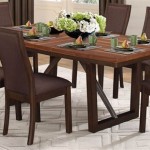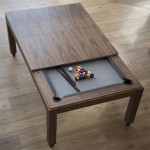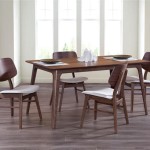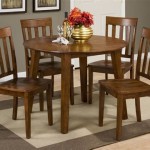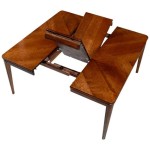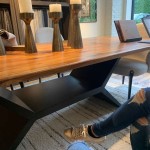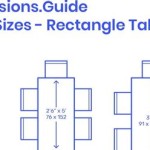```html
Oval Vs. Rectangular Dining Table: A Comprehensive Comparison
Selecting the right dining table is a crucial aspect of interior design, influencing both the functionality and aesthetic appeal of a dining space. Among the various shapes available, oval and rectangular dining tables are two of the most popular choices. Each possesses distinct characteristics that cater to different spatial needs, design preferences, and social dynamics. A thorough understanding of their individual strengths and weaknesses is essential for making an informed decision that aligns with specific requirements.
The shape of a dining table significantly impacts several factors. These include the number of people that can be comfortably seated, the ease of navigating around the table within the room, and the overall visual harmony of the space. Furthermore, the chosen shape can influence the atmosphere of dining experiences, promoting either a sense of formality or a more relaxed, communal setting. Therefore, careful consideration should be given to the unique attributes of oval and rectangular tables before committing to a purchase. This comparison will delve into the key differences between these two shapes, analyzing their suitability for various dining environments and lifestyles.
Space Utilization and Room Dimensions
One of the primary considerations when choosing between an oval and a rectangular dining table is the amount of available space and the dimensions of the dining room. Rectangular tables, with their straight edges, are generally more efficient at utilizing space in rectangular rooms. They can be placed against a wall or centered in the room without creating awkward gaps. Their linear form allows for a more structured and organized layout, particularly in smaller dining areas or those with limited width.
Oval tables, on the other hand, offer greater flexibility in terms of placement. Their curved edges can soften the harsh lines of a rectangular room and create a more inviting atmosphere. The absence of sharp corners makes them ideal for smaller spaces where maneuvering around the table is a concern. In addition, oval tables can often accommodate more people than a rectangular table of comparable length, as there are no corners that restrict seating. This makes them a suitable option for those who frequently entertain guests.
However, in very narrow rooms, an oval table might appear visually cramped and disrupt the flow of movement. The curvature could potentially encroach upon walkthrough space, making it feel less functional than a rectangular table that can be positioned closer to a wall. Therefore, it's crucial to accurately measure the dimensions of the dining room and consider the existing furniture layout before deciding on the shape. Visualizing the table in the space, either through online planning tools or by marking the dimensions on the floor, can be helpful in determining the optimal choice.
Seating Capacity and Social Interaction
The seating capacity of a dining table is directly linked to its shape and size. Rectangular tables, with their longer sides, typically offer more seating along the length of the table. This makes them well-suited for formal dining settings or for families who frequently gather for meals. The linear arrangement allows for a clear hierarchy, with designated seating for the head of the table and a more structured dining experience.
Oval tables, due to their lack of corners, promote a more inclusive and communal dining atmosphere. Everyone seated around the table is equidistant from the center, fostering a sense of equality and facilitating conversation. This makes oval tables a popular choice for informal gatherings and family meals where interaction and engagement are prioritized. The absence of corners also eliminates the feeling of being "stuck" in a corner seat, which can be uncomfortable for some individuals.
However, the lack of corners on an oval table can also be a drawback in certain situations. It may be more difficult to accommodate a large number of people comfortably, especially if the table is relatively small. While more people can technically fit around an oval table compared to a rectangular one of the same length, the seating might feel more cramped. The curved shape might also make it challenging to place serving dishes and condiments evenly around the table, potentially limiting access for some diners.
Aesthetic Appeal and Interior Design Style
The aesthetic appeal of a dining table is a subjective matter, but certain shapes tend to complement specific interior design styles. Rectangular tables, with their clean lines and geometric form, often lend themselves well to modern, minimalist, and traditional interiors. They can create a sense of order and formality, particularly when paired with matching chairs and a carefully chosen centerpiece.
Oval tables, with their softer curves and organic shape, can add a touch of elegance and sophistication to a dining room. They are particularly well-suited for transitional, contemporary, and even bohemian styles. The curved lines can help to soften the hard angles of a room and create a more inviting and welcoming atmosphere. An oval table can also serve as a focal point, drawing the eye and adding visual interest to the space.
The choice of materials and finishes further enhances the aesthetic impact of the dining table. A rectangular table made of dark wood with a glossy finish might exude a sense of formality and grandeur, while an oval table made of light wood with a matte finish might convey a more casual and relaxed vibe. The selection of chairs, lighting fixtures, and accessories should also complement the shape and style of the dining table to create a cohesive and visually appealing dining space.
Beyond the practical considerations of space and seating, the visual impact of a dining table on the overall design of a room cannot be overstated. The table often serves as the anchor piece, setting the tone for the entire room's aesthetic. A carefully chosen shape, material, and style contributes significantly to achieving the desired atmosphere and creating a space that reflects personal taste and preferences.
Cleaning and maintenance are also important considerations. Rectangular tables, with their straight edges, can be easier to clean and maintain. Spills and crumbs can be easily wiped away without having to navigate curved corners. Oval tables, on the other hand, might require a bit more effort to clean, especially if they have intricate detailing or embellishments along the edges.
Ultimately, the decision between an oval and a rectangular dining table rests on a careful evaluation of individual needs and preferences. Factors such as the size of the dining room, the number of people that need to be accommodated, the desired aesthetic style, and the frequency of entertaining should all be taken into consideration. By weighing the pros and cons of each shape, one can make an informed decision that will enhance both the functionality and the visual appeal of the dining space.
The durability of the table is also a crucial factor to consider. Both oval and rectangular tables come in a variety of materials, and the chosen material will significantly affect the table's longevity and resistance to wear and tear. Solid wood tables, whether oval or rectangular, are typically the most durable option, but they can also be more expensive. Tables made of veneer or laminate may be more affordable, but they may not be as resistant to scratches and dents.
Furthermore, the base of the table should also be considered. A sturdy base is essential for ensuring the stability of the table and preventing it from wobbling. Pedestal bases are common for oval tables, providing ample legroom and contributing to the overall aesthetic. Rectangular tables often have four legs, which can be positioned in various ways to create different visual effects. The placement of the legs can also affect the seating capacity of the table, so it's important to choose a base that allows for comfortable seating for all diners.
The height of the dining table is another important factor to consider. Standard dining tables are typically around 30 inches tall, but this can vary slightly depending on the style and design. It's important to choose a table that is the right height for the chairs that will be used with it. The chairs should be positioned so that diners can sit comfortably with their elbows at a 90-degree angle. If the table is too high or too low, it can lead to discomfort and strain.
```
Dining Table Shapes Which Is Best For You Cabinfield Blog

How To Set A Dining Table Based On The Shape

Dining Table Shapes Which Is Best For You Cabinfield Blog

Round Dining Tables Vs Rectangular

How To Set A Dining Table Based On The Shape

Dining Table Sizes How To Choose The Right One

Round Dining Tables Vs Rectangular

Expert Advice How To Design A Perfectly Scaled Dining Room The Kuotes Blog

Rectangular Dining Tables Vs Round Oval

Dining Room New Oval Table And Plans Nesting With Grace

